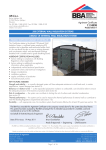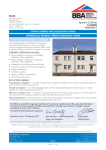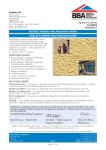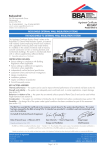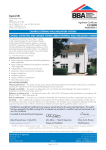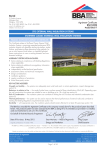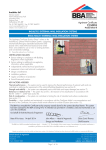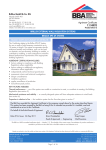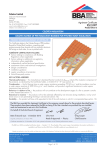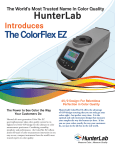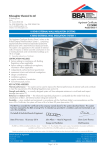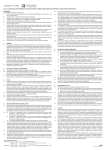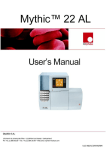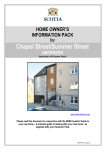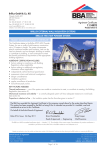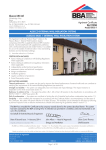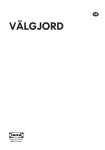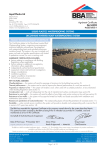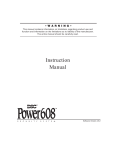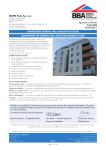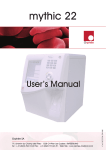Download JUB d.o.o. JUB EXTERNAL WALL INSULATION SYSTEM
Transcript
APPROVAL INSPECTION TESTING CERTIFICATION JUB d.o.o. Dol pri Ljubljani 28 SI-1262 Dol pri Ljubljani Slovenia Tel: 00 386 1 588 42 82 Fax: 00 386 1 588 42 50 TECHNICAL APPROVALS FOR CONSTRUCTION Agrément Certificate 12/4955 e-mail: [email protected] website: www.jub.eu Product Sheet 1 JUB EXTERNAL WALL INSULATION SYSTEM JUBIZOL EPS EXTERNAL WALL INSULATION SYSTEM This Agrément Certificate Product Sheet (1) relates to relates to Jubizol EPS External Wall Insulation System, comprising mechanically-fixed expanded polystyrene insulation boards with mesh-reinforced renders, and suitable for use on new or existing domestic and nondomestic buildings. (1) Hereinafter referred to as ‘Certificate’. CERTIFICATION INCLUDES: • factors relating to compliance with Building Regulations where applicable • factors relating to additional non-regulatory information where applicable • independently verified technical specification • assessment criteria and technical investigations • design considerations • installation guidance • regular surveillance of production • formal three-yearly review. KEY FACTORS ASSESSED Practicability of installation — the system must be installed by trained operatives (see section 4). Thermal performance — the system can be used to improve the thermal performance of external walls or contribute to meet the Building Regulations (see section 5). Strength and stability — a correctly designed system will have adequate resistance to wind loads and, in certain applications, impact damage (see section 6). Behaviour in relation to fire — the system has the Euroclass given in section 7. The BBA has awarded this Certificate to the company named above for the system described herein. This system has been assessed by the BBA as being fit for its intended use provided it is installed, used and maintained as set out in this Certificate. On behalf of the British Board of Agrément Date of First issue: 16 November 2012 Sean Moriarty — Head of Approvals Greg Cooper Energy and Ventilation Chief Executive Certificate amended on 22 XX Month November 20122012 to include to include QUERY. amendment to Table 2. The BBA is a UKAS accredited certification body — Number 113. The schedule of the current scope of accreditation for product certification is available in pdf format via the UKAS link on the BBA website at www.bbacerts.co.uk Readers are advised to check the validity and latest issue number of this Agrément Certificate by either referring to the BBA website or contacting the BBA direct. British Board of Agrément Bucknalls Lane Watford Herts WD25 9BA ©2012 Page 1 of 19 tel: 01923 665300 fax: 01923 665301 e-mail: [email protected] website: www.bbacerts.co.uk Regulations In the opinion of the BBA, Jubizol EPS External Wall Insulation System, if installed, used and maintained in accordance with this Certificate, will meet or contribute to meeting the relevant requirements of the following Building Regulations (the presence of a UK map indicates that the subject is related to the Building Regulations in the region or regions of the UK depicted): The Building Regulations 2010 (England and Wales) (as amended) Requirement: A1 Loading Comment: Requirement: B4(1) External fire spread Comment: Requirement: C2(b) Resistance to moisture Comment: Requirement: C2(c) Resistance to moisture The system can sustain and transmit wind loads to the substrate wall. See section 6.4 of this Certificate. The system can meet this Requirement. See sections 7.1 to 7.6 of this Certificate. The system provides a degree of protection against rain ingress. See sections 9.1 to 9.3 of this Certificate. Comment: The system contributes to minimising the risks of interstitial and surface condensation. See sections 3.5 and 10.1 and 10.3 of this Certificate. Requirement: L1(a)(i) Conservation of fuel and power Comment: The system can contribute to enabling a wall to meet the Target Emission Rate. See sections 5.1 to 5.4 of this Certificate. Requirement: Regulation 7 Materials and workmanship Comment The system is acceptable. See section 12.1 and the Installation part of this Certificate. The Building (Scotland) Regulations 2004 (as amended) Regulation: 8(1)(2) Fitness and durability of materials and workmanship The system can contribute to a construction meeting this Regulation. See sections 11.1, 12.1 and the Installation part of this Certificate. Comment: Regulation: Standard: 9 1.1 Building standards applicable to construction Structure Comment: Standard: 2.6 Spread to neighbouring buildings The system can sustain and transmit wind loads to the substrate wall. See section 6.4 of this Certificate. The system achieved a B – s1, d0 fire classification but incorporates materials which would not be classed as ‘non-combustible’. Completed walls, therefore, would be regarded as unprotected areas as defined in this Standard, with reference to clauses 2.6.1(1)(2), 2.6.2(1)(2), 2.6.4(1)(2), 2.6.5(1) and 2.6.6(2). See sections 7.1 to 7.6 of this Certificate. Comment: Standard: 2.7 Standard: 3.10 3.15 6.1(b) 6.2 Carbon dioxide emissions Buildings insulation envelope The system can contribute to satisfying this Standard, with reference to clauses (or parts of) 6.1.1(1)(2), 6.1.2(1)(2), 6.1.3(1)(2), 6.1.4(2), 6.1.6(1), 6.1.8(2), 6.1.10(2), 6.2.1(1)(2), 6.2.3(1), 6.2.4(1), 6.2.5(1)(2), 6.2.6(2), 6.2.7(2), 6.2.11(1) and 6.2.13(2). See sections 5.1 to 5.4 of this Certificate. Comment: Standard: Condensation Walls insulated with the system will satisfy the requirements of this Standard, with reference to clauses 3.15.1(1)(2), 3.15.4(1)(2) and 3.15.5(1)(2). See sections 3.5 and 10.2 and 10.3 of this Certificate. Comment: Standard: Standard: Precipitation Walls insulated with the system will contribute to a construction satisfying this Standard, with reference to clause 3.10.1(1)(2). See sections 9.1 to 9.3 of this Certificate. Comment: Standard: Spread on external walls The system incorporates materials which would not be classed as ‘non-combustible’ as defined in this Standard under clauses 2.7.1(1)(2) and 2.7.2(2) and should not, therefore, be used on walls one metre or less from a boundary. See sections 7.1 to 7.6 of this Certificate. Comment: 7.1(a)(b) Statement of sustainability The system can contribute to meeting the relevant requirements of Regulation 9, Standards 1 to 6, and, therefore, will contribute to a construction meeting a bronze level of sustainability as defined in this Standard. In addition, the system can contribute to a construction meeting a higher level of sustainability as defined in this Standard, with reference to clauses 7.1.4(1)(2) [Aspects 1(1)(2) and 2(1)], 7.1.6(1)(2) [Aspects 1(1)(2) and 2(1)] and 7.1.7(1)(2) [Aspect 1(1)(2)]. See section 5.2 of this Certificate. Comment: (1) Technical Handbook (Domestic). (2) Technical Handbook (Non-Domestic). The Building Regulations (Northern Ireland) 2012 Regulation: 23(a)(i)(ii)(iii)(b) Fitness of materials and workmanship Comment: Regulation: 28(b) Comment: The system is acceptable. See section 12.1 and the Installation part of this Certificate. Resistance to ground moisture and weather Walls insulated with the system will satisfy this Regulation. See sections 9.1 to 9.3 of this Certificate. Page 2 of 19 Regulation: 29 Condensation Walls insulated with the system will satisfy the requirements of this Regulation. See sections 3.5 and 10.3 of this Certificate. Comment: Regulation: 30 Stability Comment: Regulation: 36(a) External fire spread 39(a)(i) 40(2) Conservation measures Target carbon dioxide emission rate Comment: Regulation: The system can sustain and transmit wind loads to the substrate wall. See section 6.4 of this Certificate. The system can satisfy this Regulation. See sections 7.1 to 7.6 of this Certificate. Comment: The system can enable a construction to meet the requirements of these Regulations. See sections 5.1 to 5.4 of this Certificate. Construction (Design and Management) Regulations 2007 Construction (Design and Management) Regulations (Northern Ireland) 2007 Information in this Certificate may assist the client, CDM co-ordinator, designer and contractors to address their obligations under these Regulations. See section: 2 Delivery and site handling (2.2 and 2.4) of this Certificate. Additional Information NHBC Standards 2011 NHBC accepts the use of Jubizol EPS External Wall Insulation System, when installed and used in accordance with this Certificate, in relation to NHBC Standards, Chapter 6.9 Curtain walling and cladding. General This Certificate relates to Jubizol EPS External Wall Insulation System, comprising expanded polystyrene insulation boards with mesh-reinforced renders. The system and component are obtained from the Certificate holder. The system is applied to the outside of external walls of masonry and dense or no-fines concrete construction and are suitable for use on new or existing domestic or non-domestic buildings. Application and maintenance must be carried out strictly in accordance with this Certificate and the Certificate holder’s instructions, by installers trained and approved by the Certificate holder. Technical Specification 1 Description 1.1 The components of the basic wall system (see Figures 1 and 2) from outer to inner comprise: Finishes • mineral trowelled render — ready-mixed lime-cement-based mortar (particle sizes 2.0 mm to 2.5 mm) requiring addition of water 20% to 23% — based on lime, cement, aggregates and additives • mineral smooth render — ready-mixed lime-cement-based mortar (particle sizes 1.5 mm to 2.5 mm) requiring addition of water 20% to 23% — based on lime, cement, aggregates and additives • silicate trowelled render — ready to use paste (particle sizes 2 mm and 2.5 mm) — based on potassium silicate and water-based acrylic binder, aggregates and additives • silicate smooth render — ready to use paste (particle sizes 1.5 mm, 2 mm and 2.5 mm) — based on potassium silicate and water-based acrylic binder, aggregates and additives • silicone trowelled render — ready to use paste — (particle sizes 2 mm and 2.5 mm) — based on silicone emulsion and water-based acrylic binder, aggregates and additives • silicone smooth render — ready to use paste (particle sizes 1.5 mm, 2 mm and 2.5 mm) — based on silicone emulsion and water-based acrylic binder, aggregates and additives • Nivellin D(1) — ready-mixed polymer based mortar requiring addition of water 30% — based on polymer, lime, cement, aggregates, additives plus liquid exterior micro reinforced acrylic waterborne anti-mildew paint (only in combination with base coat Jubizol Adhesive Mortar), applied to a thickness of between 1.5 mm and 5 mm. • Nanoxil G — self-cleaning silicone smooth render — ready to use paste (particle sizes 1.5 mm, 2,0 mm and 2.5 mm) — based on water-based silicone and acrylic binders, nano structures, mineral fillers and special additives. (1) Finishing coat Nivellin D is applied without primer. Page 3 of 19 Primers Unigrund — liquid, water-based acrylic slurry primer intended as a primer for all finishing coats (except mineral based finishing coats, mineral trowelled render, mineral smooth render and Nivellin D) • • • • Akril emulsion — liquid, water-based acrylic primer intended as a primer for the mineral based finishing coats Acrylcolor — liquid exterior acrylic waterborne facade paint as a primer for the mineral based finishing coats Jubosil GX — liquid, water-based silicate primer intended as a primer for the silicate based finishing coats Jubosil G — liquid, water-based silicone primer intended as a primer for the silicone based finishing coats. Basecoat • Jubizol Adhesive Mortar — dry mix cement-base coat powder requiring addition of 20% water. Jubizol Adhesive Mortar consists of aggregates, cement, dispersion powder and special additives, applied in a thickness of between 3 mm and 6 mm • EPS Adhesive Mortar — powdered high-elasticity cement-based mortar, refined with polymer binder, requiring addition of 20% water. EPS Adhesive Mortar consists of aggregates, cement, polymer binders and special additives, applied in a thickness of between 3 mm and 4 mm. Reinforcing mesh • Jubizol Glassfibre Mesh — glassfibre mesh with a nominal weight per unit area of 160 g·m–2 and width of 1 m. • Fixings with a minimum 60 mm diameter head • polyethylene with a metal, composite or polyethylene centre pin: — EJOT Ejoterm ST U — EJOT Ejoterm STR-U — EJOT SDM-T plus — EJOT Ejoterm NT-U — EJOT Ejoterm NK-U — Pritrdilno sidro PSK — Plasticno pritrdilo PP. Fire fixing: — EJOT TID-MR, stainless steel fire fixing with a minimum 35 mm diameter head: Expanded Polystyrene EPS 70 (Expanded Polystyrene) boards (1000 mm by 500 mm) to EPS-BS EN 13163-T2-L1-W2-S2-P4-DS(N)2-DS(70,-) 1-TR150-BS100, thickness 50(1) mm to 300 mm, minimum tensile strength perpendicular to the faces 150 kPa, available in white and enhanced graphite grey. (1) 60 mm minimum insulation thickness when utilising all EJOT anchors except EJOT Ejoterm STR-U, and a minimum 80 mm insulation thickness when utilising the EJOT Ejoterm STR-U fixing. Adhesives • Jubizol Adhesive Mortar — dry mix cement-based adhesive requiring addition of 20% water • Jubizol Adhesive — dry mix cement-based adhesive requiring addition of 20% water • EPS Adhesive Mortar — powdered high-elasticity cement-based mortar, refined with polymer binder, requiring addition of approximately 20% water. 1.2 Ancillary materials must be approved by the Certificate holder. Ancillary items supplied by the Certificate holder for use in particular locations/forms of construction include: • Base profile and sills — produced with aluminium. Profiles are provided to the specifier’s requirements and approved by the Certificate holder • Expansion joint and render stop beads — PVC-U • JUB corner bead with mesh — polymer-coated glassfibre mesh adhered to a perforated 90º polystyrene PS-Hi corner bar • corner mesh • profile fixings • silicone sealant • XPS Insulation Boards. Page 4 of 19 Figure 1 Typical installation on masonry walls and typical sectional at base level existing substrate decorative render primer (if necessary) Jubizol Adhesive Mortar or Jubizol Adhesive or EPS Adhesive Jubizol Glassfibre Mesh Jubizol insulation board fixing EPS insulation board Jubizol Adhesive Mortar or EPS Adhesive Mortar primer profile fixing base profile joint seal band primer (if necessary) Jubizol Adhesive Mortar if the XPS is adhesively bonded Jubizol insulation board fixing XPS Insulation Board Jubizol Adhesive Mortar Jubizol Glassfibre Mesh primer decorative render 1.3 With all types of insulation, the boards are attached to the substrate with Jubizol insulation board fixings and supplementary adhesive (see section 6.7). 2 Delivery and site handling 2.1 The insulation is delivered to site shrink-wrapped in polythene packs bearing the manufacturer’s and product identification marks and batch numbers. 2.2 Components are delivered to site in the quantities and packages as listed in Table 1. Each package carries the manufacturer’s and product’s identification, batch number, and the BBA logo incorporating the number of this Certificate. Table 1 Component supply details Component Quantity and package Mineral render 20 kg bag Silicate and Silicone 25 kg container Jubizol Adhesive Mortar, Jubizol Adhesive Mortar and EPS Adhesive Mortar 20 kg bag Nivellin D 20 kg bag Nanoxil G 25 kg container Unigrund 18 kg plastic container Jubosil GX and G 5 litre container Jubizol Glassfibre Mesh 50 m roll, 1 m wide Fixings boxed by manufacturer Profiles 2.5m lengths Page 5 of 19 2.3 The insulation boards must be protected from prolonged exposure to sunlight and should be stored either under cover or protected with opaque polythene sheeting. Where possible, packs should be stored inside. If stored outside, the products should be stacked flat and raised above ground level, and not in contact with ground moisture. Boards that have been allowed to get wet or that are damaged must not be used. Nothing should be stored on top of boards. 2.4 The insulation boards must not be exposed to open flame or to other ignition sources. 2.5 The powder components should be stored in dry conditions, off the ground, and protected from frost at all times. Assessment and Technical Investigations The following is a summary of the assessment and technical investigations carried out on Jubizol EPS External Wall Insulation System. Design Considerations 3 General 3.1 Jubizol EPS External Wall Insulation System, when installed in accordance with this Certificate, is effective in reducing the thermal transmittance (U value) of the walls of new and existing domestic and non-domestic buildings. It is essential that the detailing techniques specified in this Certificate are carried out to a high standard, if the ingress of water into the insulation is to be avoided and the full thermal benefit obtained from treatment with the systems. 3.2 The system is applied to the outside of external walls of masonry and dense or no-fines concrete construction and is suitable for use on new or existing domestic or non-domestic buildings. 3.3 The system will improve the weather resistance of a wall and provide a decorative finish. However, they may be installed only where other routes for moisture penetration have been dealt with separately and where there are no signs of dampness on the inner surface of the wall, other than those caused solely by condensation. The system can be used to overcome condensation associated with the internal wall surface. 3.4 Existing buildings subject to national Building Regulations should have wall surfaces in accordance with section 13 Site survey and preliminary work of this Certificate. 3.5 New buildings subject to national Building Regulations should be constructed in accordance with the relevant recommendations of: • BS 8000-3 : 2001 • BS EN 1996-1-2 : 2005 • BS EN 1996-2 : 2006, in that the designer should select a construction appropriate to the local wind-driven rain index, paying due regard to the design detailing, workmanship and materials to be used • BS EN 1996-3 : 2006. 3.6 Other walls not subject to regulatory requirements should also be built in accordance with section 3.5. 3.7 When using the system, consideration must be given to the overall design to minimise the risk of condensation, and the recommendations of BS 5250 : 2011 should be followed. 4 Practicability of installation The system should only be installed by installers who have been trained and approved by the Certificate holder (see section 14 Approved installers). 5 Thermal performance 5.1 Calculations of thermal transmittance (U value) should be carried out in accordance with BS EN ISO 6946 : 2007 and BRE Report (BR 443 : 2006) Conventions for U-value calculations, using the insulation declared thermal conductivity (90/90) values of 0.039 W·m–1·K–1 and 0.032 W·m–1·K–1 for white and enhanced graphite grey EPS respectively 5.2 The U value of a completed wall will depend on the selected insulation thickness and fixing method, the insulating value of the substrate masonry and its internal finish. Calculated U values for example constructions are given in Table 2. Page 6 of 19 Table 2 Example U values (W·m–2·K–1) (1)(2) Insulation thickness (mm) U value of external wall system with enhanced graphite grey EPS (0.032 W·m–1·K–1) U value of external wall system with white EPS (0.039 W·m–1·K–1) 0.41 0.28 0.20 0.16 0.13 0.11 0.48 0.33 0.24 0.19 0.16 0.13 60 100 150 200 250 300 (1) 215 mm thickness of brickwork ( = 0.56 W·m–1·K–1), 13 mm dense plaster ( = 0.57 W·m–1·K–1). (2) Calculations based upon six 8 mm (nominal) diameter fixings per metre square with the point thermal transmittance of the fixings taken as 0.002 W·K–1. 5.3 When considering insulation requirements, designers should refer to the detailed guidance contained in the documents supporting the national Building Regulations. The U values shown in Table 2 indicate that the system can enable a wall to achieve typical design U values referred to in those supporting documents. 5.4 The system can contribute to maintaining continuity of thermal insulation at junctions between elements and openings. For Accredited Construction Details the corresponding psi values in BRE Information Paper IP 1/06 Assessing the effects of thermal bridging at junctions and around openings, Table 3 may be used in carbon emission calculations in Scotland and Northern Ireland. Detailed guidance for other junctions and on limiting heat loss by air infiltration can be found in: England and Wales — Approved Documents to Part L and for new thermal elements to existing buildings, Accredited Construction Details (version 1.0). See also SAP 2009 Appendix K and the iSBEM User Manual for new-build Scotland — Accredited Construction Details (Scotland) Northern Ireland — Accredited Construction Details (version 1.0). 6 Strength and stability 6.1 Installations incorporating the insulation system can be designed to provide adequate resistance to design loads applicable in the UK. 6.2 Positive wind load (pressure) is transferred to the substrate wall directly via bearing and compression of the render, and insulation. 6.3 Negative wind pressure (suction) is resisted by the bond between each component. The insulation boards are retained by external wall insulation system anchors. 6.4 The wind loads on the wall should be calculated in accordance with BS EN 1991-1-4 : 2005 or BS 6399-2 : 1997. Special consideration should be given to locations with high wind-load pressure coefficients as additional fixings may be necessary. In accordance with BS EN 1990 : 2002, it is recommended that a load factor of 1.5 is used to determine the ultimate wind load to be resisted by the system. 6.5 Assessment of structural performance for individual buildings must be carried out by a suitably qualified engineer to confirm that: • the substrate wall has adequate strength to resist additional loads that may be applied as a result of installing the system, ignoring any contribution from the insulation system • the proposed system and associated fixing layout provides adequate resistance to negative wind loads (based on the results of the site investigation and test results given in Table 5) (see also section 6.8). 6.6 Provided the substrate wall is suitable and an appropriate fixing is used, the mechanical fixings will transfer the weight of the rendered insulation system to the substrate wall. The number of fixings and the span between fixings should be determined by a suitably qualified engineer. The fixings must be selected to give adequate support to the weight of the system at the minimum spacing given in this Certificate. As a guide, typical pull-out strengths for the fixings are given in Table 3, however, these values are dependent on the substrate and the fixing must be selected to suit the loads and substrate concerned. A minimum of one metal fixing per m2 must be used where required to satisfy fire regulations (see section 7). Table 3 Fixings — typical pull-out strengths Fixing type Typical pull-out strength(1) (N) EJOT Ejoterm ST U EJOT Ejoterm STR-U EJOT SDM-T plus EJOT Ejoterm NT-U EJOT Ejoterm NK-U Pritrdilno Sidro PSK Plasticno Pritrdilo PP 400 600 750 500 500 300 400 (1) Values are dependent on the substrate. Page 7 of 19 6.7 The insulation system is mechanically fixed to the substrate wall with a minimum of 4 fixings per m2 or 6 fixings per m2 for the fixing pattern shown in Figures 2a and 2b respectively, and a minimum of 40% adhesive. The resistance of the insulation to pull-over of the head of a fixing is given in Table 4. Table 4 fixing pull-over resistance Anchor and plate diameter EPS thickness Location of anchors Failure load (N) 60 mm diameter — All EJOT anchors except EJOT Ejoterm STR-U ≥60 Panel joints (pull through test) 341 60 mm diameter — EJOT Ejoterm STR-U ≥80 Not at panel joints (pull through test) 550 60 mm diameter — EJOT Ejoterm STR-U ≥80 Panel joints (pull through test) 480 Plasticno Pritrdilo PP ≥50 Not at panel joints (pull through test) 445 Plasticno Pritrdilo PP ≥50 Panel joints 350 Pritrdilno Sidro PSK ≥50 Not at panel joints (pull through test) 542 Pritrdilno Sidro PSK ≥50 Panel joints (pull through test) 482 Figure 2a Typical fixing pattern — 4 fixings per m2 Figure 2b Typical fixing pattern — 6 fixings per m2 Page 8 of 19 6.8 The resistance forces data given in Table 5 are the results of calculations based upon: • fixings arranged in the pattern described and shown in section 6.7 and Figure 2a • pull-over resistances determined by the BBA from tests on anchors with 60 mm diameter plates (mean value of five tests with a factor of safety of 2.5 applied) • an appropriate number of site-specific pull-out tests conducted on the substrate of the building to determine the minimum resistance to failure of the fixings. The characteristic pull-out resistance should be determined in accordance with the guidance given in ETAG 014 : 2002, Annex D (ie by calculating the mean of the lowest five values and multiplying by 0.6). In accordance with this guideline, a factor of safety of two is applied to this figure to establish the design value to resist the ultimate loads. Table 5 Example calculation sheet to establish ultimate wind load capacity Factor EPS(1) 1000 mm x 500 mm ≥60 341 2.5 136 300 2 150 136 272 0.5 0.544 Thickness (mm) Characteristic pull-over resistance(2) (per anchor) (N) Factor of safety Design pull-over resistance(3) (N) Characteristic anchor pull-out resistance(4) (per anchor) (N) Factor of safety(5) Design pull-out resistance(6) (per anchor) (N) Limiting design value(7) (per fixing) (N) Limiting design value per board(8) (with 2 fixings) (N) Area of board (m2) Limiting pressure(kN·m–2) (1) Calculation based on insulation board 1000 mm by 500 mm (total area 0.5 m2) attached by two fixings (ie four fixings per m2). (2) Pull-over resistance of insulation over the head of the fixing. (3) The safety factor of 2.5 is based on the assumption that all insulation boards are quality control tested to establish tensile strength perpendicular to the face of the board. (4) See section 6.6. (5) See section 6.8, third bullet point. (6) The pull-over value will be limiting factor. (7) The lesser of the board design pull-over resistance and the anchor design pull-out resistance. (8) Board design pull-over resistance multiplied by the number of fixings, based upon the limiting resistance. Impact loading 6.9 Hard body impact tests were carried out in accordance with ETAG 004 : 2000. The system is suitable for use in categories(1) shown in Table 6. (1) The use categories are defined in ETAG 004 : 2000 as: • Use category I — a zone readily accessible at ground level to the public and vulnerable to hard body impacts but not subjected to abnormally rough use • Use category II — a zone liable to impacts from thrown or kicked objects, but in public locations where the height of the system will limit the size of the impact; or at lower levels where access to the building is primarily to those with some incentive to exercise care • Use category III — a zone not likely to be damaged by normal impacts caused by people or by thrown or kicked objects. Table 6 Impact resistance Finishing coat Mineral Render and Nivelin D Silicate render Granulations Mortar (mm) Base Coat Jubizol Adhesive Mortar Single mesh Double mesh Single mesh Double mesh Category II — Category III Category II — Category II — — 1.5 Category II — — — 2.0 – 2.5 Category I — — — Category I Category II Category II — — — All All Silicone render 1.5 Category II 2.0 – 2.5 Category I All Nanoxil EPS Adhesive Mortar All Category II — — — Category I Category II Category II Category I Category II Category II Page 9 of 19 7 Behaviour in relation to fire 7.1 The BS EN 13501-1 : 2007 classification for the system is B – s1, d0. 7.2 These fire ratings apply to the full range of colours covered by the Certificate. 7.3 The insulation material only is classified as combustible. 7.4 The system may be used in accordance with the provisions of: England and Wales — Approved Document B, Volume 1, paragraph 8.4, and Volume 2, paragraph 12.6 (see also Approved Document B, Volume 2, Diagram 40) Scotland — Mandatory Standards 2.6 and 2.7, clauses 2.6.1(1)(2), 2.6.2(1)(2), 2.6.4(1)(2), 2.6.5(1), 2.6.6(2), 2.7.1(1)(2) and 2.7.2(2) respectively, and Annexes 2.C(1) and 2.E(2) (1) Technical Handbook (Domestic). (2) Technical Handbook (Non-Domestic). Northern Ireland — Technical Booklet E, paragraph 5.1 (see also Diagram 5.1). 7.5 The document listed in section 7.4 give full details of permissible heights and boundary conditions of domestic and non-domestic buildings and the relevant guidance with regard to external wall claddings of external wall insulation systems with render surfaces. However, the following information is offered for guidance purposes: England and Wales, and Northern Ireland • for buildings one metre or more from a boundary, the system is acceptable • less than one metre from a boundary, provided the wall meets the relevant requirements for fire resistance from both sides and extent of unprotected areas • the system can be acceptable, subject to the aforementioned conditions, for use on a building which has a floor up to 18 m above ground level. Scotland • domestic and non-domestic use — for buildings more than one metre from a boundary, up to 18 m above ground level, the system can be acceptable. The system is not classified as non-combustible, therefore calculations for unprotected areas apply(1). (1) Combustible cladding need not be included in the calculation for unprotected areas where it is attached to the structure of the building and the external wall does not contain openings other than the small openings described in Mandatory Standard 2.6.2, clause 2.6.2b, and the wall behind the cladding has the appropriate fire-resistance duration from the inside. In Mandatory Standard 2.6, clause 2.6.2b, an unprotected area is defined as an area of not more than 0.1 m–2 which is at least 1.5 m from any other unprotected area in the same wall. 7.6 To limit the risk of fire spread between floors, cavity barriers should be installed at each floor level above the first floor (ie starting with the second storey) as detailed in BRE Report (BR 135 : 2003) Fire Performance of External Insulation for Walls of Multi-storey Buildings (see Figure 3). Vertical and horizontal lamella fire barriers should be provided at each compartment floor and wall, including the second floor level of a three-storey single occupancy house. Firebreaks should be adhesively bonded to the substrate and mechanically fixed with stainless steel fire fixings at 300 mm centres, fixed through the reinforcing mesh. The fire barrier should be of a non-combustible material, eg mineral fibre, be at least 200 mm high, continuous and unbroken for the full perimeter of the building and for the full thickness. Figure 3 Cavity barrier 2nd floor inside cavity barrier 1st floor insulation 7.7 In buildings not subject to the Building Regulations, it is recommended that designers should consider the guidance given in section 7.6. 7.8 In buildings of more than two storeys, stainless steel fire fixings must be provided at the rate of one per square metre. The fixing design should take account of the extra duty required under fire conditions (see also section 15.20). Page 10 of 19 7.9 The insulation system covered by this Certificate does not incorporate cavities between the insulation and the substrate, however, fire barriers should be incorporated into a construction, where required by the relevant Building Regulations, to maintain the continuity of fire resistance. Further details are given in: England and Wales — Approved Document B, Volume 1, Section 6, and Volume 2, Section 9 Scotland — Mandatory Standard 2.4, clauses 2.4.1(1)(2), 2.4.2(1)(2), 2.4.7(1) and 2.4.9(2) (1) Technical Handbook (Domestic). (2) Technical Handbook (Non-Domestic). Northern Ireland — Technical Booklet E, Section 3, paragraphs 4.36 to 4.40. 8 Proximity of flues and appliances When the system is installed in close proximity to certain flue pipes the relevant provisions of the national Building Regulations should be met: England and Wales — Approved Document J Scotland — Mandatory Standard 3.19, clause 3.19.4(1)(2) (1) Technical Handbook (Domestic). (2) Technical Handbook (Non-Domestic). Northern Ireland — Technical Booklet L. 9 Rain penetration 9.1 The system will provide a degree of protection against rain ingress. However, care should be taken to ensure that walls are adequately weathertight prior to its application. 9.2 Designers and installers should take particular care in detailing around openings, penetrations and movement joints to minimise the risk of rain ingress. 9.3 For externally insulated single-leaf masonry walls, guidance is given in BS EN 1996-1-1 : 2005 and BS EN 998-2 : 2010 on the minimum thickness of render required for the different exposure categories. 9.4 Guidance given in BRE Report (BR 262 : 2002) Thermal insulation: avoiding risks should be followed in connection with the weathertightness of solid wall constructions. The designer should select a construction appropriate to the local wind-driven rain index, paying due regard to the design detailing, workmanship and materials to be used. Additional guidance can be found in: England and Wales — Approved Document C, Section 5 Scotland — Mandatory Standard 3.10(1)(2) (1) Technical Handbook (Domestic). (2) Technical Handbook (Non-Domestic). Northern Ireland — Technical Booklet C, Section 6.. 9.5 At the tops of walls, the system should be protected by an adequate overhang or other detail designed for use with this type of system (see section 15.25). 9.6 The fixing of rainwater goods, satellite dishes, clothes lines, hanging baskets and similar items is outside the scope of this Certificate. 9.7 It is essential that the system is installed and maintained in accordance with the conditions set out in this Certificate. 10 Condensation Surface condensation 10.1 Walls will limit the risk of surface condensation adequately when the thermal transmittance (U value) does not exceed 0.7 W·m–2·K–1 at any point and the junctions with other elements are designed in accordance with the relevant requirements of the publications referred to in section 5.4. 10.2 Walls will adequately limit the risk of surface condensation when the thermal transmittance (U value) does not exceed 1.2 W·m–2·K–1 at any point. Guidance may be obtained from Section 8 of BS 5250 : 2011, Annex G. Additional information can be found in BRE Report (BR 262 : 2002). Interstitial condensation 10.3 Walls incorporating the system will adequately limit the risk of interstitial condensation when they are designed and constructed in accordance with BS 5250 : 2011, Annexes D and G and the relevant guidance. 10.4 If the system is to be used on the external walls of rooms expected to have continuous high humidities, care must be taken in the design of the rooms to avoid possible problems from the formation of interstitial condensation in the wall. 10.5 The rendering system equivalent air layer thickness (Sd ) are shown in Tables 7 and 8. Page 11 of 19 Table 7 Equivalent air layer thickness (system with Jubizol Adhesive Mortar Base Coat) Rendering system tested with: Base coat Jubizol Adhesive Mortar and finishing coats indicated here after (including corresponding key coat): Mineral render, 1.5 mm Silicate render, 2.0 mm Silicone plaster, 2.0 mm Nivelin D Nanoxil, 2.0 mm Equivalent air layer thickness (Sd) 0.1 0.1 0.2 0.1 0.3 m m m m m Table 8 Equivalent air layer thickness (system with EPS Adhesive Mortar Base Coat) Rendering system tested with: Base coat EPS Adhesive Mortar and finishing coats indicated here after (including corresponding key coat): Mineral render, 1.5 mm Silicate render, 2.0 mm Silicone plaster, 2.0 mm Nanoxil, 2.0 mm Equivalent air layer thickness (Sd ) 0.1 0.2 0.3 0.3 m m m m 10.6 The resistivity of the EPS boards can be taken as between 100 MN·s·g–1·m–1 to 200 MN·s·g–1·m–1. 11 Maintenance and repair 11.1 Regular checks should be made on the installed system, particularly at joints, to ensure that ingress of water does not occur. Necessary repairs should be carried out immediately. 11.2 Damaged areas must be repaired using the appropriate components and the procedures detailed in the Certificate holder’s installation instructions. 12 Durability 12.1 The results of accelerated ageing tests in accordance with ETAG 004 : 2000 indicate that the system is durable. The system should remain effective for at least 25 years, provided any damage to the surface finish is repaired immediately, and regular maintenance is undertaken (see section 11). This includes checks on joints in the system and on penetrations to enable corrective action to be taken to rectify the defects. 12.2 The finish may become discoloured with time. The rate at which this occurs will depend on the initial colour, the degree of exposure, the level of atmospheric pollution and the design and detailing of the wall. In common with traditional renders, discoloration by algae and lichens may occur in wet areas. Installation 13 Site survey and preliminary work 13.1 A pre-installation survey of the property is carried out to determine suitability for treatment and the need for any necessary repairs to the building structure before application of the Jubizol EPS External Wall Insulation System. A specification is prepared for the building indicating: • the position of beads • detailing around windows, doors and at eaves • damp-proof course (dpc) level • exact position of expansion joints • areas where flexible sealants must be used • any alterations to external plumbing • where required, the position of fire barriers. 13.2 The survey should include tests conducted on the walls of the building by the Certificate holder or their Approved installers (see section 14) to determine the adequacy of the substrate. 13.3 Trial tests are conducted on the wall to determine the pull-out resistance of the proposed mechanical fixings. An assessment and recommendation is made on the type and number of fixings required to withstand the building’s expected wind loading based on calculations using the test data, the relevant wind speed data for the site and, in the absence of a formal requirement, a safety factor of 2 (see Table 5). Where required to comply with fire regulations, at least one fixing per board should be of a non-combustible type (see section 7.6). 13.4 All modifications and necessary repairs to the building are completed before installation commences. 13.5 Surfaces should be sound, clean and free from loose material. The flatness of surfaces must be checked; this may be achieved using a straight edge spanning the storey height. Any excessive irregularities, ie greater than 10 mm in 1 m, must be made good prior to installation to ensure that the insulation boards are installed with a smooth, in-plane finished surface. Page 12 of 19 13.6 Where surfaces are covered with an existing rendering, it is essential that the bond between the background and the render is adequate. All loose areas should be hacked off and reinstated. 13.7 On existing buildings, purpose-made window sills must be fitted to extend beyond the finished face of the system). New buildings should incorporate suitably deep sills. 13.8 It is recommended that external plumbing be removed before installation and alterations made to underground drainage, where appropriate, to accommodate repositioning of the plumbing on the finished face of the systems. 13.9 New buildings should be of sound masonry, dense or no-fines concrete construction. 13.10 Internal wet work, eg screeding or plastering, should be completed and allowed to dry prior to the application of a system. 14 Approved installers Application of the system, within the context of this Certificate, is carried out by installers recommended or recognised by the Certificate holder. Such an installer is a company: • employs operatives who have been trained and approved by the Certificate holder to install the system and who, upon completion of their training, have been issued with an appropriate identification card by the Certificate holder • which has undertaken to comply with the Certificate holder’s application procedure, containing the requirement for each application team to include at least one member with the correct trade/supervisory skills • subject to supervision by the Certificate holder. This may include unannounced site inspections. 15 Procedure General 15.1 Application is carried out in accordance with the current installation instructions of the Certificate holder. 15.2 Weather conditions should be monitored to ensure correct application and curing conditions. The system should not be applied at temperatures below 5°C or above 25°C, if exposure to frost is likely or in damp/wet conditions. The render must be protected from rapid drying and should not be applied on elevations in direct sunlight or where the substrate is hot. 15.3 All rendering should be in accordance with the relevant recommendations of BS EN 13914-1 : 2005. 15.4 Before installation takes place, the building designer must confirm where items such as rainwater goods, satellite dishes, clothes lines and hanging baskets will be placed. The fixing points for these items must be specifically designated and built into the system as the insulation is installed. This is outside the scope of this Certificate. 15.5 The base profile is secured to the external wall above the dpc using mechanical fixings at a minimum of 300 mm centres. Beads and expansion joints are fitted as specified. 15.6 Fire stops are installed in accordance with the Certificate holder’s instructions at locations defined in the project specific site package. Positioning and securing insulation boards 15.7 The adhesive is mixed in a suitable container using potable water and a high power drill and mixer spiral to create a paste-like mortar whilst ensuring there are no clots in the mixed material. 15.8 Details of mechanical fixings (including their arrangement in the insulation boards) are specified in the project specific design requirements based on pull-out test results and wind loading data. A minimum of 4 or 6 mechanical fixings per square metre should be installed unless otherwise specified in the project specific design (see also section 6.7). Holes are drilled into the substrate through the insulation, and the fixings are installed, fixed tightly to the insulation board using the dedicated driving system to ensure there is no risk of pull off. Care must be taken to ensure that the fixings are not overdriven. 15.9 XPS skirting boards are then fixed to the wall below dpc to provide the necessary capillary action resistance. To minimise the effects of cold bridging the XPS should extend below ground level where possible. Where this is not possible the first run of XPS Insulation Boards are positioned at ground level. 15.10 The insulation boards are positioned on the starter track and initially bonded to the wall by applying the specified adhesive to the boards using the ribbon and dab method. A circumferential ribbon of adhesive at least 3 cm wide is applied to the insulation boards. 6 to 8 evenly distributed patches of adhesive 8 cm to 12 cm in diameter are then applied to the boards so that an adhesive surface of at least 40% is achieved. Alternatively, for even and smooth substrates, the whole panel can be coated with adhesive using a notched trowel to produce a coat 2 mm to 5 mm in thickness. The insulation panel should be immediately placed on the substrate and pressed into place. 15.11 Subsequent rows of boards are positioned so that the vertical board joints are staggered and overlapped at the building corners. 15.12 Care must be taken to ensure that all insulation board edges are butted tightly together, and alignment is checked as work proceeds. Foam filler approved by the Certificate holder may be used for filling gaps up to 5 mm. Larger gaps shall be filled with strips of the ETICS insulation material. Page 13 of 19 15.13 Any high spots or irregularities should be removed by lightly planning with a rasp. The surface of the boards should be smooth without high spots or irregularities. After sufficient stabilisation of the installed insulation (normally 2 days, during which time the insulation should be protected from exposure to extreme weather conditions to prevent degradation), the wall is ready for the application of the basecoat. 15.14 At all locations where there is a risk of insulant exposure, eg window reveals or eaves, the system must be protected, eg by an adequate overhang or by purpose made sub-sills, seals or flashing. Building corners, door and window heads and jambs are formed using angle beads in accordance with the manufacturer’s instructions. 15.15 To fit around details such as doors and windows, insulation boards may be cut with a sharp knife or a finetooth saw. Purpose-made window sills, seals and deflection channels, designed to prevent or manage water ingress and allow water to be shed clear of items bridging the cavity, should be fitted (see Figure 4). Only details approved by the Certificate holder should be used. 15.16 Purpose-made powder coated aluminium window sills (complete with sill end caps) are installed in accordance with the Certificate holder’s instructions. They are designed to prevent water ingress and incorporate drips to shed water clear of the system (see Figures 4 and 5). Figure 4 Window sill/reveal detail silicone sealant window reveal bead PVC-U closure trim window frame decorative render see Figure 5 sheet sill sill to bear on and to be mechanically fixed to adequate structural support (insulation should not bear weight of sill) EPS board insulation primer for better adhesion Jubizol Adhesive Mortar Jubizol Glassfibre Mesh Jubizol Adhesive Mortar Jubizol insulation board fixing EPS insulation primer (if necessary) existing concrete sill existing substrate Page 14 of 19 Figure 5 Window sill close up upstand, where slope extends beyond reveal by more than 75 mm, and sill slope is 10° minimum, upstand is not required recommended fall 10° or greater Movement joints 15.17 Movement joints should be incorporated where required. Existing structural expansion joints should be extended through to the surface of the insulation system (see Figure 6). Figure 6 Movement Joint Detail existing movement joint in wall external insulation build-up EPS insulation boards cut in line with existing movement joint render only movement joint bead with mesh wings, to be lapped over existing mesh layer on mineral wool insulation board existing sealant compressible seal tape between EPS insulation boards 6 mm PVC-U movement joint bead of similar colour to render finish coat Page 15 of 19 Basecoat and reinforcing 15.18 The basecoat is prepared as described above and is trowel applied to the surface of dry insulation boards in two steps to achieve the overall thickness (see section 1.1). Initially insulation boards are coated with 2/3 of the final base coat thickness. A 10 mm toothed trowel (held at 45° to the insulation board) is used to leave castellations in the basecoat. A layer of alkali resisting glassfibre mesh is then bedded into the coat ensuring the mesh is overlapped at joint by a minimum coverage of 100 mm (overlaps in quoins should be minimum 150 mm). The mesh should be pressed into the base coat using a notched float so that it is not visible, yet is should not make direct contact with the Insulation. The remaining 1/3 thickness of base coat is then applied as required to ensure the mesh is completely covered and the required minimum thickness of base coat is achieved. 15.19 Additional pieces of reinforcing mesh are applied diagonally at the corners of openings to provide the necessary reinforcement in accordance with the Certificate holder’s instructions (see Figure 7). Additional layers of mesh may be applied to improve impact resistance. Figure 7 Additional reinforcement at openings 15.20 In buildings of more than two storeys, stainless steel fire fixings must be provided at the rate of one per square metre. The fixing design should take account of the extra duty required under fire conditions. Fixings are inserted into the centre of each board through the wet mesh adhesive. Rendering and finishing 15.21 Prior to the render coat, the relevant seals are positioned and installed at all openings (eg windows and doors), overhanging eaves, gas and electric meter boxes, wall vents or where the render abuts any other building material or surface. This helps to reduce the risk of water ingress into the structure. 15.22 The basecoat must be allowed to dry/cure (approximately 3 days) prior to the application of the primer/finish coat. Prior to the application of the finishing coat, sealant should be applied as required, as defined in the project specific site package in accordance with the Certificate holder’s instructions. 15.23 Primers (see section 1.1 for list of primers and their compatibility with the finishing coats) shall be applied in accordance with the Certificate holders instructions and allowed to dry for approximately 12 hours prior to the application of the Finishing Coat. 15.24 Finishing coats are applied in accordance with the Certificate holder’s instructions. 15.25 Care should be taken in the detailing of the system around features such as openings, projections and at eaves (see Figure 8) to ensure adequate protection against water ingress and to limit the risk of water penetrating the system. Page 16 of 19 Figure 8 Typical roof eaves detail — installation on existing building plastic reveal bead primer (if necessary) Jubizol insulation board fixing external substrate decorative render primer Jubizol Adhesive Mortar Jubizol Glassfibre Mesh Jubizol Adhesive Mortar EPS board insulation Technical Investigations 16 Tests An examination was made of data relating to: • component characterisation • water vapour permeability • water absorption • bond strength • reaction to fire • pull-out strength of fixings • durability of finish coatings • heat/spray cycling • impact resistance. 17 Investigations 17.1 The manufacturing process, the methods adopted for quality control of manufactured and bought-in components, and details of the quality and composition of the materials used, were examined. 17.2 An assessment of the risk of interstitial condensation was undertaken. 17.3 The practicability of installation and the effectiveness of detailing techniques were examined. Page 17 of 19 Bibliography BS 5250 : 2011 Code of practice for control of condensation in buildings BS 6399-2 : 1997 Loading for buildings — Code of practice for wind loads BS 8000-3 : 2001 Workmanship on building sites — Code of practice for masonry BS EN 998-2 : 2010 Specification for mortar for masonry — Masonry mortar BS EN 1990 : 2002 Eurocode — Basis of structural design BS EN 1991-1-4 : 2005 Eurocode 1 : Actions on structures — General actions — Wind actions BS EN 1996-1-1 : 2005 Eurocode 6 : Design of masonry structures — General rules for reinforced and unreinforced masonry structures BS EN 1996-1-2 : 2005 Eurocode 6 : Design of masonry structures — General rules — Structural fire design BS EN 1996-2 : 2006 Eurocode 6 : Design of masonry structures — Design considerations, selection of materials and execution of masonry BS EN 1996-3 : 2006 Eurocode 6 : Design of masonry structures : Simplified calculation methods for unreinforced masonry structures BS EN 13163 : 2008 Thermal insulation products for buildings — Factory made products of expanded polystyrene (EPS) — Specification BS EN 13501-1 : 2007 Fire classification of construction products and building elements — Classification using test data from reaction to fire tests BS EN 13914-1 : 2005 Design, preparation and application of external rendering and internal plastering — External rendering BS EN ISO 6946 : 2007 Building components and building elements — Thermal resistance and thermal transmittance — Calculation method ETAG 004 : 2000 Guideline for European Technical Approval of External Thermal Insulation Composite Systems with Rendering ETAG 014 : 2002 Guideline for European Technical Approval of Plastic Anchors for fixing of External Thermal Insulation Composite Systems with Rendering Page 18 of 19 Conditions of Certification 18 Conditions 18.1 This Certificate: • relates only to the product/system that is named and described on the front page • is issued only to the company, firm, organisation or person named on the front page — no other company, firm, organisation or person may hold or claim that this Certificate has been issued to them • is valid only within the UK • has to be read, considered and used as a whole document — it may be misleading and will be incomplete to be selective • is copyright of the BBA • is subject to English Law. 18.2 Publications, documents, specifications, legislation, regulations, standards and the like referenced in this Certificate are those that were current and/or deemed relevant by the BBA at the date of issue or reissue of this Certificate. 18.3 This Certificate will remain valid for an unlimited period provided that the product/system and its manufacture and/or fabrication, including all related and relevant parts and processes thereof: • are maintained at or above the levels which have been assessed and found to be satisfactory by the BBA • continue to be checked as and when deemed appropriate by the BBA under arrangements that it will determine • are reviewed by the BBA as and when it considers appropriate. 18.4 The BBA has used due skill, care and diligence in preparing this Certificate, but no warranty is provided. 18.5 In issuing this Certificate, the BBA is not responsible and is excluded from any liability to any company, firm, organisation or person, for any matters arising directly or indirectly from: • the presence or absence of any patent, intellectual property or similar rights subsisting in the product/system or any other product/system • the right of the Certificate holder to manufacture, supply, install, maintain or market the product/system • actual installations of the product/system, including their nature, design, methods, performance, workmanship and maintenance • any works and constructions in which the product/system is installed, including their nature, design, methods, performance, workmanship and maintenance • any loss or damage, including personal injury, howsoever caused by the product/system, including its manufacture, supply, installation, use, maintenance and removal • any claims by the manufacturer relating to CE marking. 18.6 Any information relating to the manufacture, supply, installation, use, maintenance and removal of this product/ system which is contained or referred to in this Certificate is the minimum required to be met when the product/system is manufactured, supplied, installed, used, maintained and removed. It does not purport in any way to restate the requirements of the Health and Safety at Work etc. Act 1974, or of any other statutory, common law or other duty which may exist at the date of issue or reissue of this Certificate; nor is conformity with such information to be taken as satisfying the requirements of the 1974 Act or of any statutory, common law or other duty of care. British Board of Agrément Bucknalls Lane Watford Herts WD25 9BA ©2012 Page 19 of 19 tel: 01923 665300 fax: 01923 665301 e-mail: [email protected] website: www.bbacerts.co.uk



















